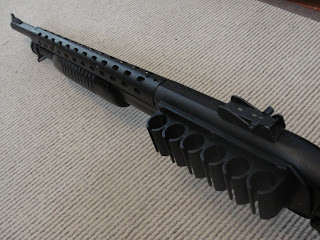How To Hone a Hunting Knife Into Something You Can Shave With
(story by Keith McCafferty - Field & Stream - March 2011)
BY NOW JUST ABOUT everyone has heard of
127 Hours, the critically acclaimed movie inspired by Aron Ralston, the climber who was pinned by a boulder in Utah and spent an hour sawing his arm off with a dull knife blade. It's a dramatic film, but I don't think moviegoers would have had to close their eyes for as long if Ralston had carried a pocket hone in his pack, or even a piece of fine-grit sandpaper.
Sharpening a knife so that it is keen enough to sever your limb, or, less drastically, skin and butcher a deer, really isn't that difficult. All you really need to render a serviceable edge is a stone, a little spit and a steady hand, and even the spit is debatable.
True Grit Traditional bench stones have largely been supplanted by diamond-encrusted surfaces and synthetics including ceramics and Japanese water stones. I still prefer a good Arkansas bench stone, but as a rule the type of stone is not as important as its grit equivalent. One that sports a medium-coarse grit (325 to 400) on one side and medium-fine 600 grit on the other will cover most sharpening bases. Grandpa invariably prepared his stone with oil, on the assumption that it was needed to "float" away metal particles during honing. Today, many experts recommend using water or no lubrication at all. Shell out the extra sawbuck or two for a bench-size stone about 2 1/2" wide by 8 inches long. It will have a more substantial surface that will sharpen a blade more evenly than a smaller stone.
Bevel and Burr Most hunting or utility knives are ground to an edge bevel of about 20 degrees. The easiest way to maintain that angle is with a blade guide that clamps over the knife's spine. Drink decaf to keep a steady hand and you won't need a guide for blades shorter than 4 inches. Place the edge against the stone at the correct angle and use either your thumb or two fingers on the back of the blade to guide it. With light pressure, push the blade away from you, imagining that you are slicing off a thin sliver of the stone.
Keep sharpening the same side, counting strokes, until a thin ridge of steel, called a burr, is raised on the other side (you can feel it by running your finger past the edge). This means you've ground the bevel completely flush with the stone. Only then should you turn the blade over.
Using the identical number of strokes, repeat the process on the other side. The blade should now be sharp enough to catch on your thumbnail and shave hairs off your forearm. If you use your knife mostly for slicing cuts - field dressing, butchering, cutting cord and wood - stop right now. The medium coarse stone leaves microserrations in the steel that give it more edge surface and bite for performing general camp chores. For whittling and skinning, particularly fine detail work like caping a head for a trophy mount, or if you just want to show off by shaving your beard, you'll need to progress to a finer-grit stone.
Finishing Touch To render your blade razor sharp, repeat the procedure with a 600-grit stone surface. This removes some of the microserrations left by the coarser stone. Afterward you can polish the edge even keener with a 1,200-grit stone or a leather strop, which I prefer. Prepare the strop - a wide leather belt will suffice - with a one-time application of a rubbing compound such as aluminum oxide. Place the blade nearly flat against the strop with the edge facing you and stroke the blade down its length, spine first. Flip the blade over and draw it back up. A dozen reps should do it.
I recommend supplementing your bench stones with a lightweight field sharpener. It's just the ticker for touching up an edge when you're halfway done boning an elk - or you need to get through that last inch of gristle an muscle that attaches your hand to your forearm.
Photo Credits: Field & Stream
Check out our extensive selection of sharpeners!
http://www.outdoorpursuitscanada.com/categories/Sharpening-Systems/
We have everything from Japanese bench stones to lightweight pocket sharpeners to deluxe diamond systems!









